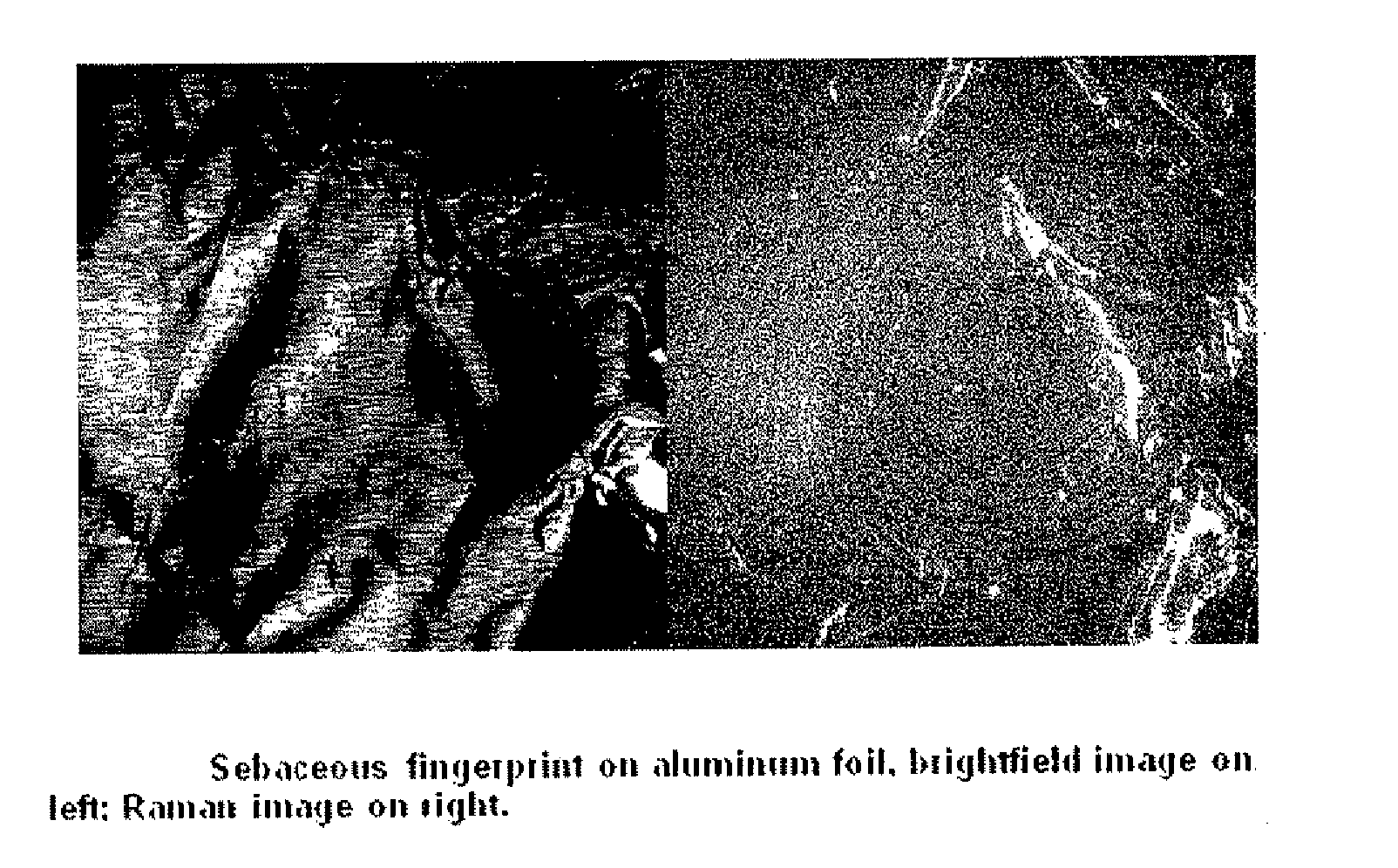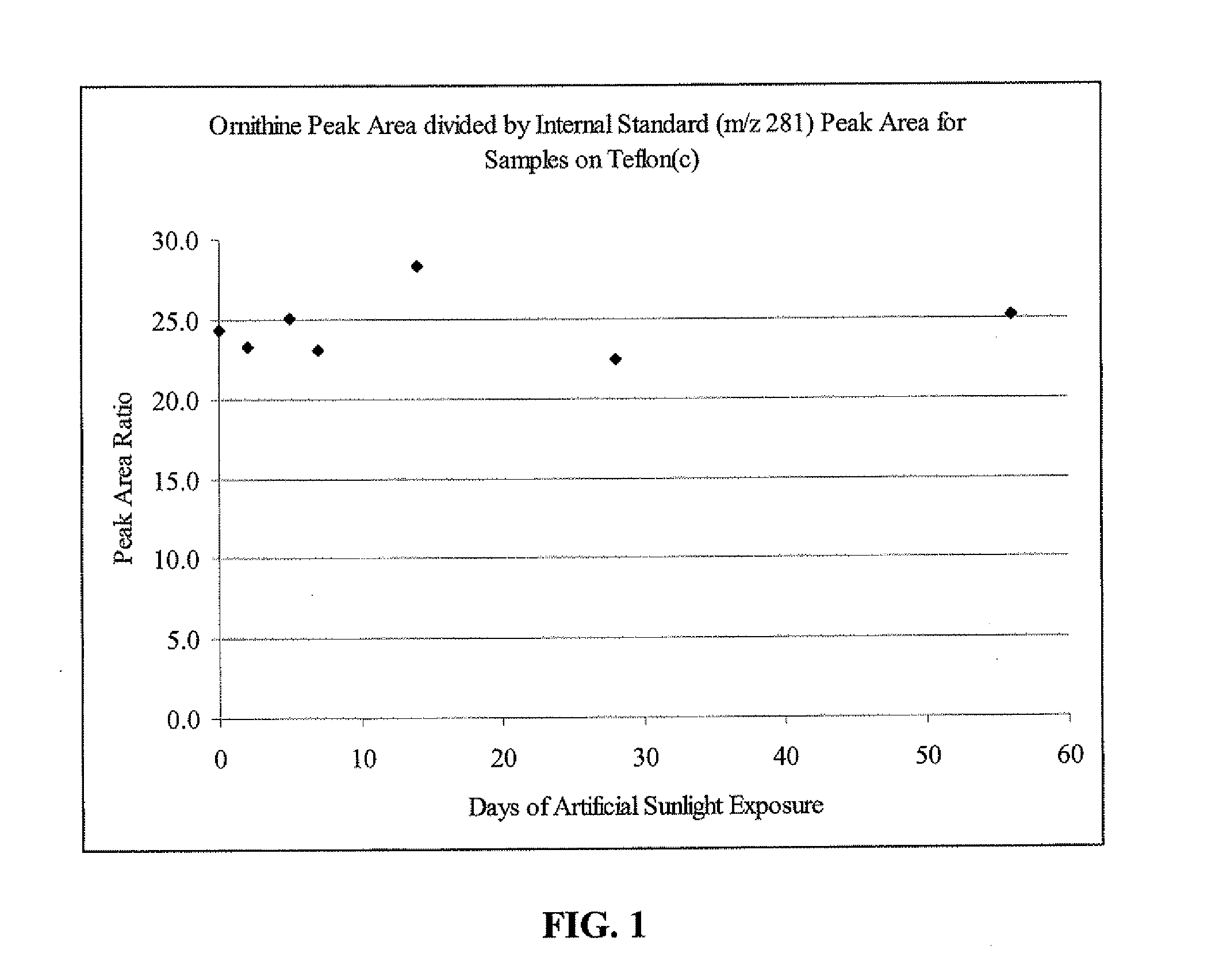Detection of latent prints by raman imaging
a technology of latent fingerprints and imaging techniques, applied in the field of forensic detection and analysis of fingerprints, can solve the problems of difficult imaging techniques to elucidate fingerprints, difficult to image (i.e., detection) of latent fingerprints, and often ample time for decomposition of latent fingerprints
- Summary
- Abstract
- Description
- Claims
- Application Information
AI Technical Summary
Benefits of technology
Problems solved by technology
Method used
Image
Examples
example 1
Artificial Fingerprint Formulation
[0055]Hamilton's quantitative data of the individual amino acids plus urea found in an eccrine-only thumbprint (see Hamilton P. B. “Amino-acids on Hands”Nature, 1965; 205 (4968), 284-285) was combined with reference data from the Geigy Scientific Tables on eccrine sweat secretions (see “Sweat” Lentner C, editor; Geigy Scientific Tables. Volume I: Units of Measurement, Body Fluids, Composition of the Body, Nutrition. 8th rev. ed. West Caldwell, N.J.: Ciba-Geigy Limited, 1981; 108-112) to create a 44-component artificial eccrine fingerprint solution, as shown in Table 2 below.
TABLE 2Artificial Eccrine Fingerprint Solutionmg / L%Components(=μg / mL)CompositionAMINO ACIDS:Serine399.217.16Glycine191.003.42Ornithine (as Ornithine HCl)205.463.68Aspartic acid109.711.97Histidine100.081.79Alanine92.591.66Threonine76.841.38Lysine57.631.03Valine54.580.98Leucine51.710.93Glutamic acid (as monohydrate)53.260.95Proline45.380.81Phenylalanine41.440.74Tyrosine38.960.70Iso...
example 2
Photodegradation Studies of the Artificial Fingerprint Formulation
[0057]Using gas-tight syringes for precise volume control, 28 μL (equivalent to the standard volume of material in one fingerprint) of the individual 5× amino acid standards were deposited on separate sets of seven Teflon® discs (22 mm-diameter) and seven steel coupons (19.6 mm×15.8 mm×4.4 mm), for a total of 98 amino acid samples. The samples were allowed to dry overnight in the dark, before being exposed to a 200-500 Watt Xe / HgXe Arc Lamp intense light source (Oriel Corporation Model 87301, Stratford, Conn.) for periods of time equivalent to 0, 2, 5, 7, 14, 28, and 56 days. The light source emits visible, UV-A, UV-B, and UV-C wavelengths, simulating 365 days of sunlight exposure in 24 hours of lamp use. Table 3 (below) provides the lamp exposure times that correlated with the desired duration of continuous sunlight exposure. The same sample preparation procedure was repeated with the 250× Urea and 100× Lac standards...
example 3
Thermal Degradation Studies of the Artificial Fingerprint Formulation
[0058]Thin galvanized steel coupons (15.7 mm×15.7 mm×0.5 mm) were wiped with acetonitrile and methanol to remove lubrication oils used in the coupon-cutting process, sanded with 4000-grit (or better) sandpaper to remove any possible surface oxidation, and wiped again with acetonitrile and methanol. Using gas-tight syringes for precise volume control, 28 μL of the 5× standard amino acid mixture was deposited on four steel coupons. The samples were allowed to dry overnight in the dark. A commercially-available 120-V, 1200-W heat gun (Black&Decker Model No. 9756, Hunt Valley, Md.) was turned on to the “high” setting for at least three minutes. A vise-grip clamp was used to grasp a steel coupon along its edge and suspend it directly over the heat gun, with the non-deposited side facing the heat source. A thermocouple (Omega Engineering, Stamford, Conn.) in contact with the steel coupon measured the temperature experien...
PUM
 Login to View More
Login to View More Abstract
Description
Claims
Application Information
 Login to View More
Login to View More - R&D
- Intellectual Property
- Life Sciences
- Materials
- Tech Scout
- Unparalleled Data Quality
- Higher Quality Content
- 60% Fewer Hallucinations
Browse by: Latest US Patents, China's latest patents, Technical Efficacy Thesaurus, Application Domain, Technology Topic, Popular Technical Reports.
© 2025 PatSnap. All rights reserved.Legal|Privacy policy|Modern Slavery Act Transparency Statement|Sitemap|About US| Contact US: help@patsnap.com



